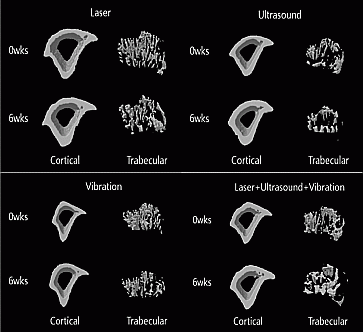ICCBH2015 Poster Presentations (1) (201 abstracts)
The mechanical multi-stimulation for musculoskeletal disease
Ji Hyung Park 1 , Seungkwan Cho 1 , Dong-Hyun Seo 1 , Dong-Hyun Hwang 1 , Tae-Young Han 2 & Han Sung Kim 1
1Yonsei-Fraunhofer Medical Device Laboratory, Yonsei University, Wonju, Republic of Korea; 2Fraunhofer Institute IKTS-MD, Dresden, Germany.
Osteoporosis takes the form of porous bone loss which is due to aging, insufficient exercise and unbalanced nutrition and so on. A number of treatments were developed to treat the osteoporosis, which were categorized by pharmacological and non-pharmacological methods. However, it is generally accepted that taking too much pharmacological medication may be harmful to the health. Thus, non-pharmacological treatments are considered as the alternative ways to overcome the side effects of pharmacological medication. Moreover, non-pharmacological treatments, such as vibration, laser, and ultrasound therapy, would be more easily applied to old people, disabled person, patients. The principle of physical stimuli effect could explain by mechanostat and daily stress. Therefore, the aim of this study is to evaluate the effects of mechanical multi-stimulation applied on the mice tibia with morphological characteristics. Twenty five female C57BL/6 mice (12-weeks-old) were used for the experiment. The study was carried out on five groups (control; Con, Laser, Vibration; Vib, Ultrasound; Ultra, and Multi Stimulation; MS) of animals each consisting of five mice. Five groups of mice were ovariectomized to induce osteoporosis. Animals were scanned at 0 and 6 weeks after ovariectomy by using micro computed tomography to estimate morphological characteristics of tibial trabecular bone. Morphological analysis showed that structural parameters of multi-stimulation group appear better phase in BV/TV, Tb.Th, Tb.N, Tb.Sp, SMI, and Conn.Dn than sham even single stimulation groups. We evaluated the effects of multi-stimuli for treatment or prevention of osteoporosis. Taken together, the results showed that multi-stimuli could suppress the continuous progress of bone deterioration, thinning and disconnectivity than single stimulus and sham group. This study suggests that multi-stimulation may restrain the change as the degenerate phase on osteoporosis in the mice tibia.
Disclosure: The authors declared no competing interests.

Figure 1 The changes of cortical and trabecular bone of tibia.




